cbr 01.2 - aircraft operations pt 1
0.0(0)
Card Sorting
1/38
Earn XP
Description and Tags
Study Analytics
Name | Mastery | Learn | Test | Matching | Spaced |
|---|
No study sessions yet.
39 Terms
1
New cards
Instrument Procedure Design
* Instrument procedures are designed separately for each **runway** and each **runway category**
* The procedure design regards aircraft performance with
* All engines operating
* References tracks or bearings
* So that neccesary wind corrections have to be introduced by the crew
* The procedure design regards aircraft performance with
* All engines operating
* References tracks or bearings
* So that neccesary wind corrections have to be introduced by the crew
2
New cards
Types of departure procedures
* Straight departure
* Turning departure
* Turning departure
3
New cards
Straight departure
* Departure track within 15° from the centreline
* Wherever possible, designation of a straight departure is preferable, but the design of the procedure is determined by the surrounding terrain and airspace characteristics
* Wherever possible, designation of a straight departure is preferable, but the design of the procedure is determined by the surrounding terrain and airspace characteristics
4
New cards
Turning depature
* Each time a change of track greater than 15° is required, the procedure is called a turning departure
* However, they require a segment of straight climb until the height of 394 ft (120 m) above the **Departure End of the Runway (DER)** is reached
* In cases which turning is not advised until reaching the **DER,** such info is always placed on the departure chart
* Usually, procedure design allows for the **Turning Point (TP) location** not earlier than **600 meters** from the departure threshold
* However, they require a segment of straight climb until the height of 394 ft (120 m) above the **Departure End of the Runway (DER)** is reached
* In cases which turning is not advised until reaching the **DER,** such info is always placed on the departure chart
* Usually, procedure design allows for the **Turning Point (TP) location** not earlier than **600 meters** from the departure threshold
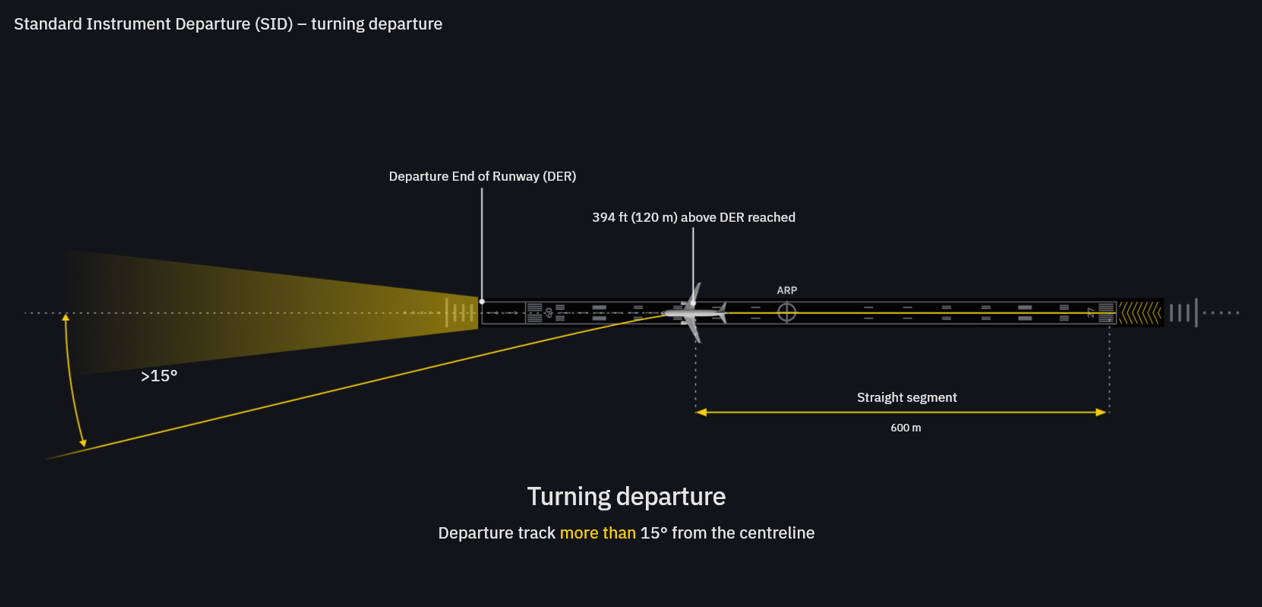
5
New cards
Use of **omnidirectional procedures**
Used when:
* An aerodrome is not equipped with a navigation aid suitable for an instrument procedure design
* he navigation aid does not provide any track guidance
* An aerodrome is not equipped with a navigation aid suitable for an instrument procedure design
* he navigation aid does not provide any track guidance
6
New cards
define **omnidirectional departure**
A kind of procedure that can be applied at aerodromes which **do not** require a specifc route to be flown for **obstacle avoidance** or for **ATC purposes**
7
New cards
advantages of **omnidirectional procedures**
* Possibility of flexible adjustment of track to the demands of each flight
* **However,** the aircraft has to climb at least 120 m/394 ft on the extended centreline before commencing the first turn
* A turn of more than 15° may be made only if 90 m/295 ft obstacle clearance is provided
* **However,** the aircraft has to climb at least 120 m/394 ft on the extended centreline before commencing the first turn
* A turn of more than 15° may be made only if 90 m/295 ft obstacle clearance is provided
8
New cards
Obstacle avoidance with omnidirectional departures
* **Sector borders** can be defined by bearings and distances from the centre of the turn area
* The standard **Procedure Design Gradient (PDG)** for a departure procedure is equal to **3.3%**
* However, sector restriction may influence the **minimum altitude** or **minimum gradient of climb** required during departure
* The standard **Procedure Design Gradient (PDG)** for a departure procedure is equal to **3.3%**
* However, sector restriction may influence the **minimum altitude** or **minimum gradient of climb** required during departure
9
New cards
How is procedure climb gradient affected when more than one sector is restricted?
* Omnidirectional departures
* Omnidirectional departures
Procedure climb gradient will be the highest required
10
New cards
How do obstacles in the proximity of the aerodrome affect departures?
If they rule out omnidirectional departure procedure introduction, the **required ceiling and visibility** have to allow for **maintaining visual terrain separation** during the departure
11
New cards
What are **protected areas** in **instrument approaches?**
* **Specified protected areas** are on both sides of the track centreline to provide for **obstacle clearance in a straight segment**
* Generally, it is comprised of a **primary** and **secondary area**
* Sometimes, there are cases when only the primary is specified
* Generally, it is comprised of a **primary** and **secondary area**
* Sometimes, there are cases when only the primary is specified
12
New cards
**Primary protected area**
* Where full obstacle clearance is assured in the primary area
* Constitutes half of the total width of the protected area
* Obstacle clearance provided decreases from obstacle clearance at the inner edge, to zero at the outer edge
* Constitutes half of the total width of the protected area
* Obstacle clearance provided decreases from obstacle clearance at the inner edge, to zero at the outer edge
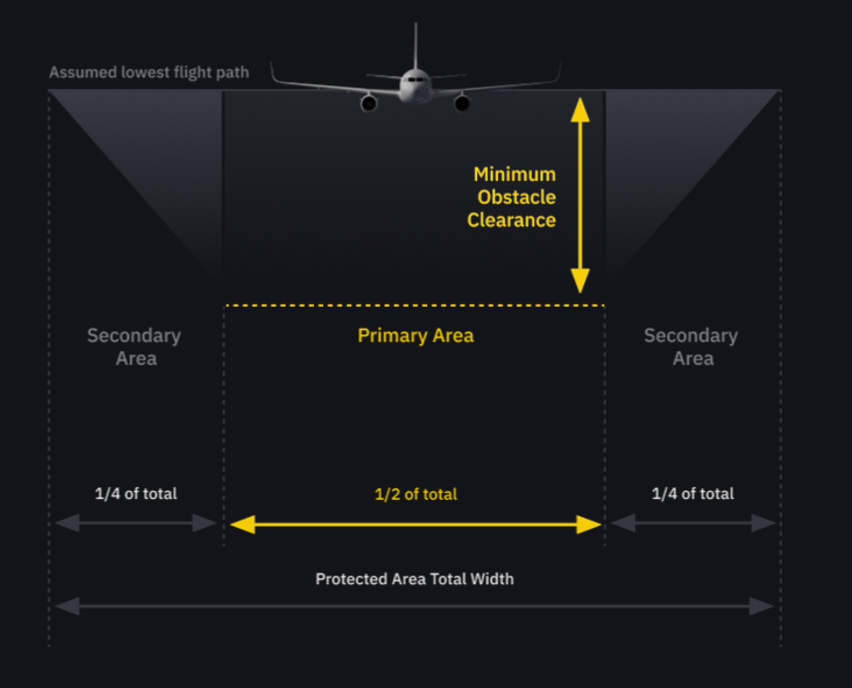
13
New cards
What 5 segments are instrument procedures divided into?
1. Arrival segment
2. Initial approach segment
3. Intermediate approach segment
4. Final approach segment
5. Missed approach segment
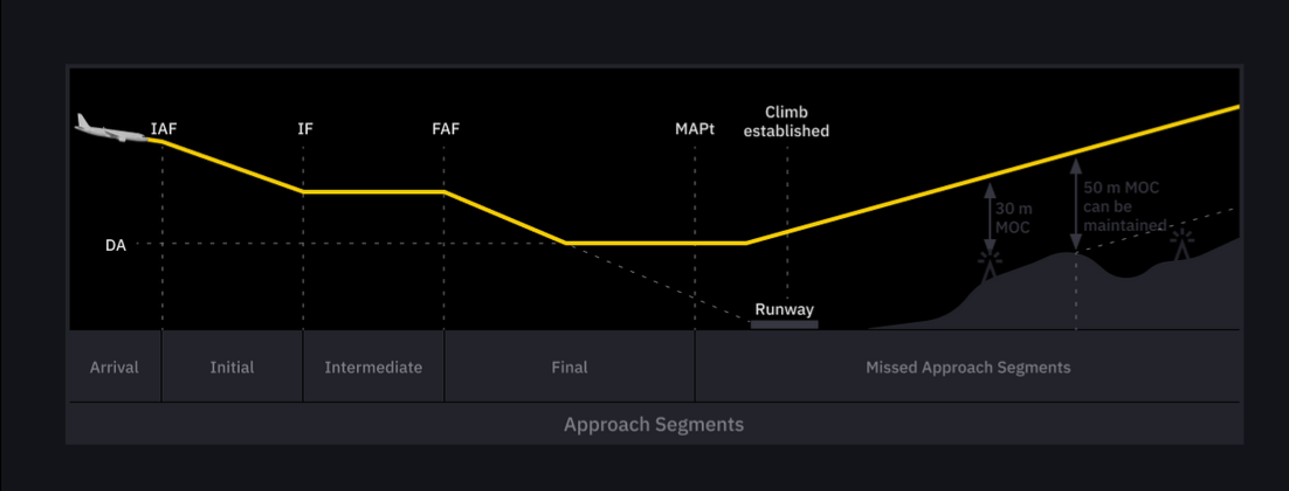
14
New cards
How do the 5 segments for instrument procedures differ?
* In terms of surfaces or areas providing obstacle protection
* Each one’s beginning and ending is designated by a **fix**
* Each one’s beginning and ending is designated by a **fix**
15
New cards
**Arrival segment**
* A transition between the en-route and approach phase of flight
* Lasts up to the Initial Approach Fix (IAF)
* IAF marks beginning of the initial approach segment
* Lasts up to the Initial Approach Fix (IAF)
* IAF marks beginning of the initial approach segment
16
New cards
**Initial approach segment**
* Begins at the **Initial Approach (IAF)**
* Ends at the **Intermediate Fix (IF)**
* MOC in the primary area equals **at least 1,000 ft/300 m**
* Maximum intermediate segment interception angle equals 90º for PAs, 120º for NPAs
* Ends at the **Intermediate Fix (IF)**
* MOC in the primary area equals **at least 1,000 ft/300 m**
* Maximum intermediate segment interception angle equals 90º for PAs, 120º for NPAs
17
New cards
**Intermediate approach segment**
* Begins at the **Intermediate Fix (IF)**
* Ends at the **Final Approach Fix (FAF)**
* A point of transition onto the final approach segment
* Speed and configuration adjustments for landing
* Small gradient of descent
* **MOC** - at least 492 ft / 150 m
* Ends at the **Final Approach Fix (FAF)**
* A point of transition onto the final approach segment
* Speed and configuration adjustments for landing
* Small gradient of descent
* **MOC** - at least 492 ft / 150 m
18
New cards
**Final approach segment**
* Begins at the **Final Approach Fix (FAF)**
* Ends at the **Missed Approach Point (MAPt)**
* Alignment and final descent for landing
* Straight-in landing or circling
* Final approach configuration and speed
* Optimum descent 3º (5.2%)
* **MOC -** 492 ft / 150 m to zero
* Ends at the **Missed Approach Point (MAPt)**
* Alignment and final descent for landing
* Straight-in landing or circling
* Final approach configuration and speed
* Optimum descent 3º (5.2%)
* **MOC -** 492 ft / 150 m to zero
19
New cards
**Missed approach segment**
* Begins at the **Missed Approach Point (MAPt)**
20
New cards
What are **fix tolerance area dimensions** dependent on?
* Distance from the facility
* Accuracy of the navigation aid
* Calculated separately for
* ILS
* VOR
* NDB
* Accuracy of the navigation aid
* Calculated separately for
* ILS
* VOR
* NDB
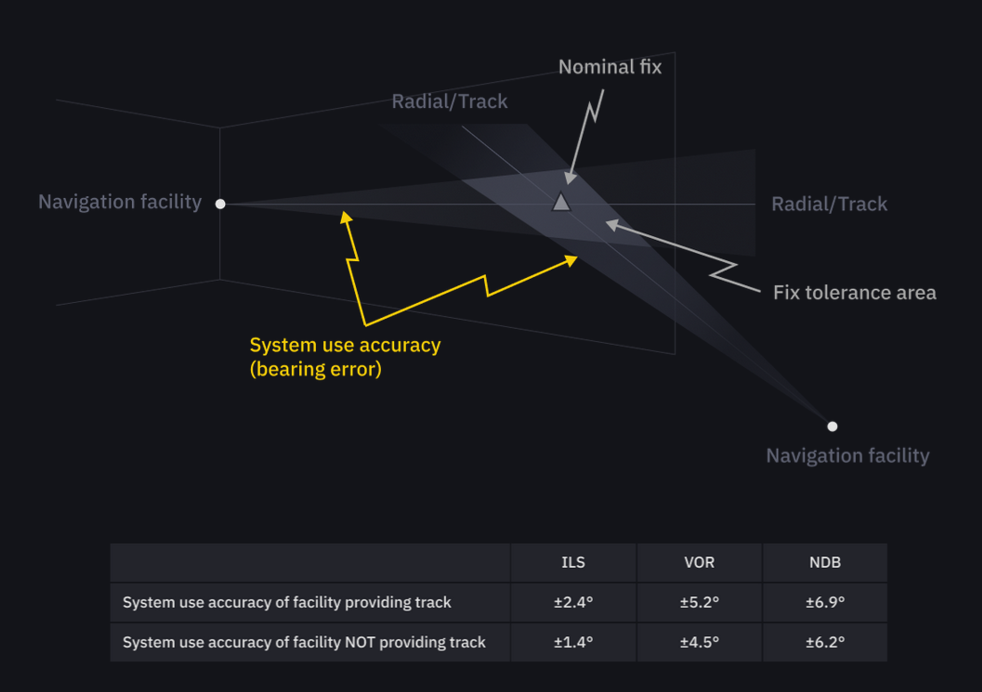
21
New cards
Tolerance area navigation aid accuracy factors
Calculated on a **root sum square** of the following:
* Ground system tolerance
* Airborne receiving system tolerance
* Flight technical tolerance
* Only applies to facilities providing **track**
* Ground system tolerance
* Airborne receiving system tolerance
* Flight technical tolerance
* Only applies to facilities providing **track**
22
New cards
Angular accuracy of an **ILS localizer (LOC)**
* Providing track guidance: ± 2.4º
* Not providing track: ± 1.4º
* Not providing track: ± 1.4º
23
New cards
Angular accuracy of an **VOR**
* Providing track guidance: ± 5.2º
* Not providing track: ± 4.5º
* Not providing track: ± 4.5º
24
New cards
Angular accuracy of an **VOR**
* Providing track guidance: ± 6.9º
* Not providing track: ± 6.2º
* Not providing track: ± 6.2º
25
New cards
define **Final Approach Fix (FAF)**
* Its maximum distance from the threshold should be equal to 10 NM
* Fix tolerance should not be larger than 1 NM
* Specified for each Non-Precision Approach (NPA)
* For Precision Approaches (PA), a FAP, marking the beginning of the precision segment, is designated instead of the FAF
* Fix tolerance should not be larger than 1 NM
* Specified for each Non-Precision Approach (NPA)
* For Precision Approaches (PA), a FAP, marking the beginning of the precision segment, is designated instead of the FAF
26
New cards
Descent gradient for precision approach
* Preferably should be planned according to the optimum glide path angle of 3º, which accounts for 5.2% descent gradient
* This is a standard value, but can be increased when necessary due to obstacles or noise abatement
* This is a standard value, but can be increased when necessary due to obstacles or noise abatement
27
New cards
Equation for glide path angle
grad \[%\] = tan(5.5º) x 100 = 9.6º
28
New cards
Aircraft categories by aircraft speed
* Based on aircraft speed at threshold (Vat), which is calculated as:
* 1.3 times stall speed in clean configuration (Vso)
* 1.23 times stall speed in landing configuration with the maximum certified take-off mass (Vs1g)
* 1.3 times stall speed in clean configuration (Vso)
* 1.23 times stall speed in landing configuration with the maximum certified take-off mass (Vs1g)
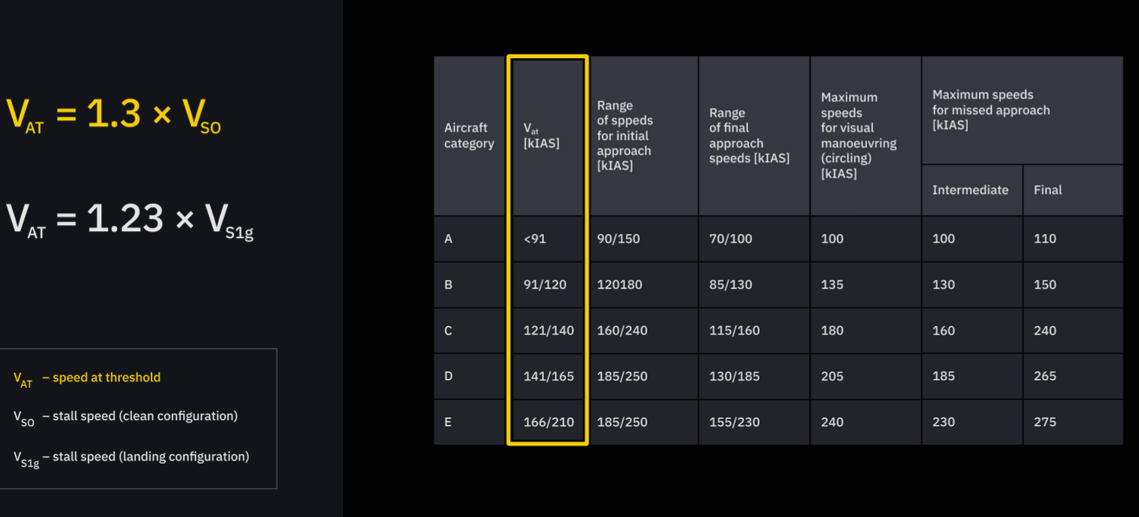
29
New cards
Types of approach
* Straight-in approach
* Circling approaches
* Circling approaches
30
New cards
Straight-in approach
Deflected from the runway centreline by a maximum of 30º right or left are preferable
31
New cards
Circling approach
* Used when terrain or other constraints make it impossible to remain in the acceptable range of runway alignment
* In most cases, the final approach track of such a procedure is aligned with some portion of the runway
* In most cases, the final approach track of such a procedure is aligned with some portion of the runway
32
New cards
Types of obstacle clearance
* Minimum Sector Altitude (MSA)
* Terminal Arrival Altitude (TAA)
\
Used to provide at least 1,000 ft/300 m obstacle clearance in each sector of a usually 25 NM-radius circle from a specific point
* Terminal Arrival Altitude (TAA)
\
Used to provide at least 1,000 ft/300 m obstacle clearance in each sector of a usually 25 NM-radius circle from a specific point
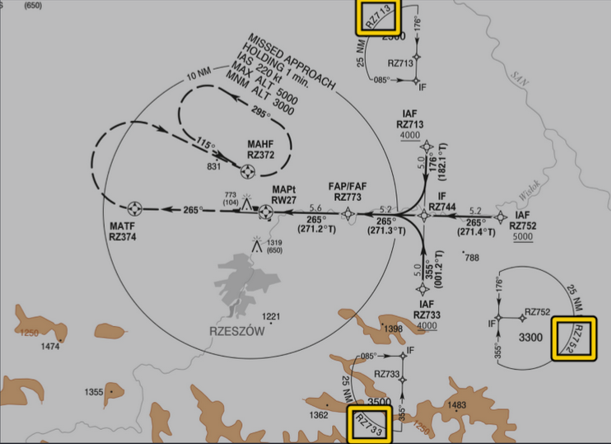
33
New cards
What the specific point of an obstacle clearance sector is based off of
* RNAV point
* Aerodrome Reference Point (ARP)
* For MSA
* Navigational aid associated w/ the approach procedure
* For TAA
* Initial Approach Fix (IAF) or Intermediate Fix (IF)
* Aerodrome Reference Point (ARP)
* For MSA
* Navigational aid associated w/ the approach procedure
* For TAA
* Initial Approach Fix (IAF) or Intermediate Fix (IF)
34
New cards
Define **Obstacle Clearance Altitude/Height (OCA/H)**
The lowest altitude, or height above the threshold or aerodrome elevation, that the pilot can descend to, and which still provides the appropriate obstacle clearance
35
New cards
OCA/H for **Precision Approach (PA)** or **Approach Procedure w/ Vertical guidance (APV)**
* Defined as the **lowest altitude (OCA)** or t**he lowest height (OCH)** above the threshold elevation
* A Missed Approach (MAP) must be initiated to ensure compliance with the appropriate obstacle clearance criteria
* A Missed Approach (MAP) must be initiated to ensure compliance with the appropriate obstacle clearance criteria
36
New cards
OCA/H for **Non Precision Approach (NPA)**
* **Lowest altitude** **(OCA)**
* **Lowest height** above aerodrome elevation (OCH)
* Further descent violates obstacle clearance criteria
* Includes **Minimum Obstacle Clearance (MOC)** over the highest approach obstacle
* Fixed value of 90 m / 295 ft for approaches without **Final Approach Fix (FAF)**
* 75 m / 246 ft for approaches with FAF
* **Lowest height** above aerodrome elevation (OCH)
* Further descent violates obstacle clearance criteria
* Includes **Minimum Obstacle Clearance (MOC)** over the highest approach obstacle
* Fixed value of 90 m / 295 ft for approaches without **Final Approach Fix (FAF)**
* 75 m / 246 ft for approaches with FAF
37
New cards
Visual manoeuvring (circling) OCA/H
* Lowest altitude
* Lowest height above aerodrome elevation (OCH)
* Further descent violates obstacle clearance criteria
* Obstacle clearance criteria - obstacle height plus MOC
* MOC is a fixed margin dependent on aircraft category
* OCH minimum value dependent on aircraft category
* Lowest height above aerodrome elevation (OCH)
* Further descent violates obstacle clearance criteria
* Obstacle clearance criteria - obstacle height plus MOC
* MOC is a fixed margin dependent on aircraft category
* OCH minimum value dependent on aircraft category
38
New cards
Operational minima factors
* Meteorological conditions
* Crew training
* Aerodrome specifications
* Offset approach track
* Altimeter error/temperature error
* Category of operation
* Crew training
* Aerodrome specifications
* Offset approach track
* Altimeter error/temperature error
* Category of operation
39
New cards
define **operation minima**
OCA/OCH + Operational safety margin
* Precision approaches, approaches with vertical guidance
* Decision Altitude/Height (DA/H)
* Non-precision approaches
* Minimum Descent Altitude/Height (MDA/H)
* Circling approaches
* Minimum Descent Altitude/Height (MDA/H)
* Precision approaches, approaches with vertical guidance
* Decision Altitude/Height (DA/H)
* Non-precision approaches
* Minimum Descent Altitude/Height (MDA/H)
* Circling approaches
* Minimum Descent Altitude/Height (MDA/H)